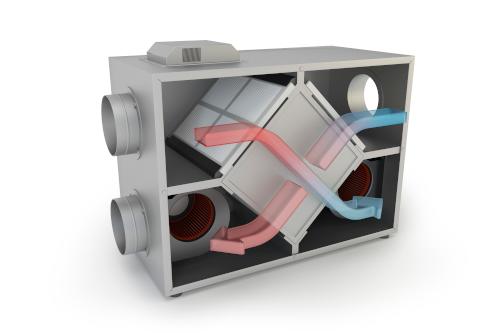Reliable Ventilation in Ithaca, Rochester, Syracuse, & Nearby
Healthier air starts with efficient ventilation
Outdoor air enters and leaks out of a house through infiltration, natural ventilation, and mechanical ventilation. If too little outdoor air enters a home, pollutants can accumulate to unhealthy and uncomfortable levels. That is why Halco provides reliable energy recovery ventilation (ERV) and heat recovery ventilation (HRV) systems that regulate indoor air.
Schedule a ventilation estimate to learn more. We proudly serve New York homeowners in Rochester, Ithaca, Syracuse, and areas nearby.
How outdoor air enters & leaves the home
- Infiltration: The process by which outdoor air flows into the house through openings, joints, and cracks in walls, floors, ceilings, windows, and doors.
- Natural ventilation: When outdoor air enters through open windows and doors.
- Mechanical ventilation: When outdoor air enters through the heating, ventilation, and air conditioning system.

Practice proper ventilation: Using kitchen and bathroom vents will reduce indoor air pollutants by exhausting excess moisture and foul odors.
Spot vs. whole-home ventilation
Spot ventilation refers to the use of a localized exhaust fan to intermittently remove air from a single room, such as bathrooms and kitchens. They remove pollutants at the source as they are generated and play an important role in the overall indoor air quality. Spot ventilation would also include dryer vents and even stovetop ventilation.
Whole-home ventilation systems treat your entire home rather than specific rooms or areas. These systems work to pull stale, polluted air from your home and replace it with fresh outdoor air.
Let your home breathe with reliable ventilation
Proper home ventilation helps in two ways: first, it introduces clean, fresh air while expelling pollutant-laden air. It also helps prevent moisture build-up. There are various ventilation strategies to help achieve this, including spot ventilation, energy recovery ventilation systems, as well as passive and active attic ventilation.
Spot ventilation may not seem like it belongs in this list, because it is separate from a home's living space, but it is important. Attic vents, including ridge, soffit, and gable-end, are often where much of the polluted, moist air in a home is expelled.
The benefits of a ventilation system
Air introduced into the home through a quality ventilation system helps maintain positive pressure, keeping the air fresher and cleaner. Ventilation also helps reduce carbon monoxide (CO) levels as well as reduce lingering odors from smoke, food preparation, cleaning products, and more.
Out with the bad air & in with the good
Heat recovery ventilation (HRV) and energy recovery ventilation (ERV) systems were developed to serve the ventilation needs of tightly sealed, well-insulated houses. Leaky, inefficient buildings have plenty of uncontrolled air exchanges through gaps, cracks, and openings, providing pathways for air infiltration and air exfiltration. But in an energy-efficient home that has a tightly sealed "building envelope," indoor air can easily become stale, unpleasant, and even hazardous. It can accumulate odors from cooking and bathing, as well as other pollutants.
HRVs and ERVs eliminate this problem by exchanging stale indoor air for fresh outdoor air. Both ventilation systems are designed to work with forced-air heating and cooling systems.
Transfer heat & humidity to save energy

Balanced ventilation: A heat recovery ventilator (HRV) is a fan-powered appliance designed to exhaust stale indoor air outside while pulling in an equal volume of fresh outdoor air. Click the diagram to enlarge.
What happens on a cold winter day when your HRV exhausts heated treated air outside and sucks in frigid outdoor air? The answer is shown in the illustration of the HRV system to the right. A specially designed corrugated core forces outgoing warm and incoming cold air streams to pass very close to one another, separated only by a thin membrane. A large amount of heat from the exhaust air is transferred to the incoming air, effectively preheating the outdoor air before it joins the heating system's ductwork.
In summer, the heat transfer works in reverse, allowing an HRV to cool incoming outdoor air. In predominantly cooling climates, ERVs are usually installed instead of HRVs because they can reduce the amount of humidity that comes into the house from outside.
Our specialists can determine whether you need an ERV or an HRV system by the climate where you live.
Improve your home's comfort, energy efficiency, & air quality
There are many systems that work together to keep the air in your home healthy, comfortable, and inexpensive to heat and cool. There are also many problems that may need to be corrected to ensure a comfortable, energy-efficient home.
The technicians at Halco are trained to identify these issues and design a customized plan for your home. We can measure your home's air exchange rate and install an HRV or ERV if necessary. We'll work with you to provide the best possible results: a healthy, comfortable home with lower operating costs.
Call us at 315-946-6200 or contact us online to schedule an estimate. We provide services to customers in New York, including Auburn, Webster, Lansing, Pittsford, Cortland, Canandaigua, Fairport, and areas nearby.
our service area
We serve the following areas
- Adams Basin
- Avon
- Bloomfield
- Brockport
- Caledonia
- Canandaigua
- Churchville
- Conesus
- Dalton
- Dansville
- East Rochester
- Fairport
- Farmington
- Geneseo
- Groveland
- Hamlin
- Hemlock
- Henrietta
- Hilton
- Honeoye
- Honeoye Falls
- Hunt
- Ionia
- Lakeville
- Leicester
- Lima
- Livonia
- Macedon
- Mendon
- Middlesex
- Mount Morris
- Naples
- North Chili
- Nunda
- Ontario
- Penfield
- Piffard
- Pittsford
- Rochester
- Rush
- Rushville
- Scottsburg
- Scottsville
- Shortsville
- Spencerport
- Springwater
- Victor
- Walworth
- Webster
- West Henrietta



